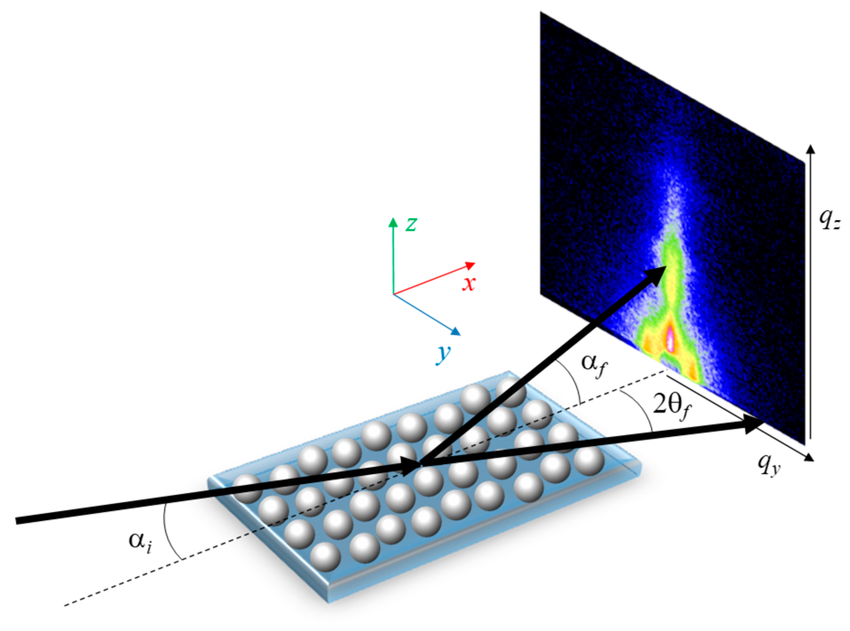Grazing-Incidence Small-Angle X-Ray Scattering (GISAXS) for Surface Nanostructures
What is GISAXS?
Grazing-Incidence Small-Angle X-Ray Scattering (GISAXS) is an advanced X-ray scattering technique used to characterize nanostructures at surfaces and interfaces. It combines the principles of small-angle X-ray scattering (SAXS) with a grazing-incidence geometry to probe the structural properties of thin films, nanoparticles, and nanocomposites with high sensitivity and resolution.

Key Features of GISAXS
GISAXS offers several key features that make it a powerful technique for studying nanostructures at surfaces and interfaces:
- Surface Sensitivity: By using a grazing-incidence geometry, GISAXS selectively probes the surface and near-surface regions of the sample, providing information about the nanostructures present at the interface.
- Non-Destructive: GISAXS is a non-destructive technique that does not require any sample preparation or modification, making it suitable for in-situ and real-time studies of nanostructure formation and evolution.
- Statistical Averaging: GISAXS provides ensemble-averaged information about the size, shape, and spatial distribution of nanostructures over a relatively large sample area, ensuring good statistics and representativeness of the results.
GISAXS Setup and Scattering Geometry
In a typical GISAXS experiment, a highly collimated X-ray beam is directed onto the sample surface at a grazing incidence angle, typically below the critical angle for total external reflection. The X-rays interact with the surface and near-surface nanostructures, resulting in scattering in the forward direction.
The scattered X-rays are collected by a two-dimensional (2D) detector positioned perpendicular to the incident beam. The resulting 2D scattering pattern contains information about the size, shape, and spatial arrangement of the nanostructures on the surface.
Data Analysis and Interpretation
The analysis of GISAXS data involves extracting quantitative information from the 2D scattering patterns. This is typically done by fitting the scattering data with appropriate models that describe the nanostructure's size, shape, and distribution.
Some common models used in GISAXS analysis include:
- Form Factor: Describes the shape and size of individual nanostructures, such as spheres, cylinders, or islands.
- Structure Factor: Accounts for the spatial arrangement and correlation between nanostructures, such as lattice spacing or inter-particle distance.
- Distorted Wave Born Approximation (DWBA): Considers the refraction and reflection effects at the sample surface, which are important for grazing-incidence geometries.
By fitting the GISAXS data with appropriate models, researchers can extract quantitative parameters such as nanostructure size, shape, spacing, and size distribution. This information is crucial for understanding the growth mechanisms, stability, and functionality of nanostructured surfaces and interfaces.
Applications of GISAXS
GISAXS has found widespread applications in various fields of nanotechnology, including:
- Thin Film Characterization: GISAXS is extensively used to study the morphology and growth of thin films, such as polymers, semiconductors, and metal oxides. It provides information about the film thickness, roughness, and internal structure.
- Nanoparticle and Quantum Dot Arrays: GISAXS is employed to characterize the size, shape, and spatial arrangement of nanoparticles and quantum dots on surfaces. This is relevant for applications in catalysis, sensing, and optoelectronics.
- Block Copolymer Self-Assembly: GISAXS is a powerful tool for studying the self-assembly of block copolymers into ordered nanostructures, such as lamellae, cylinders, or spheres. It provides insights into the microphase separation and long-range order of these systems.
- Surface Patterning and Lithography: GISAXS is used to characterize the nanostructures created by various surface patterning techniques, such as nanoimprint lithography, block copolymer lithography, or self-assembled monolayers.
Advantages and Limitations
GISAXS offers several advantages over other nanostructure characterization techniques. It is non-destructive, provides ensemble-averaged information, and is sensitive to both surface and near-surface nanostructures. It can be performed in situ and in real-time, allowing for the monitoring of nanostructure formation and evolution.
However, GISAXS also has some limitations. It requires access to synchrotron radiation sources or high-intensity X-ray sources for optimal performance. The data analysis can be complex and requires specialized software and expertise. Additionally, GISAXS provides averaged information over a relatively large sample area, so it may not capture local variations or inhomogeneities in the nanostructure.
Further Reading
Journal of Applied Crystallography, Grazing incidence small-angle X-ray scattering: an advanced scattering technique for the investigation of nanostructured polymer films
